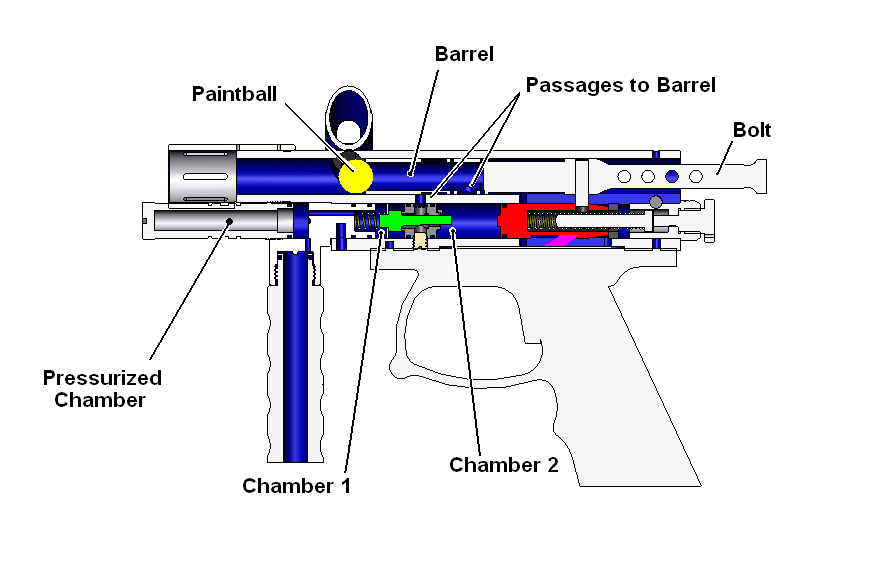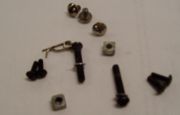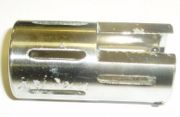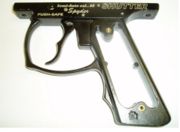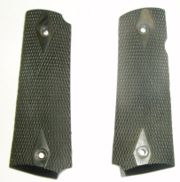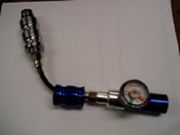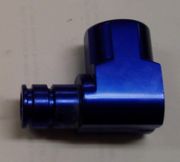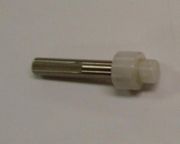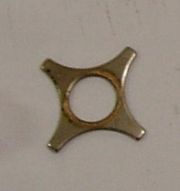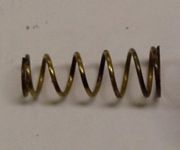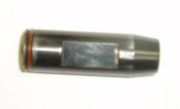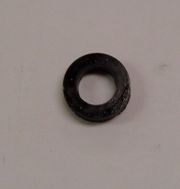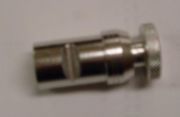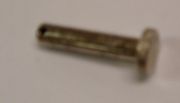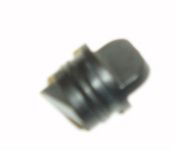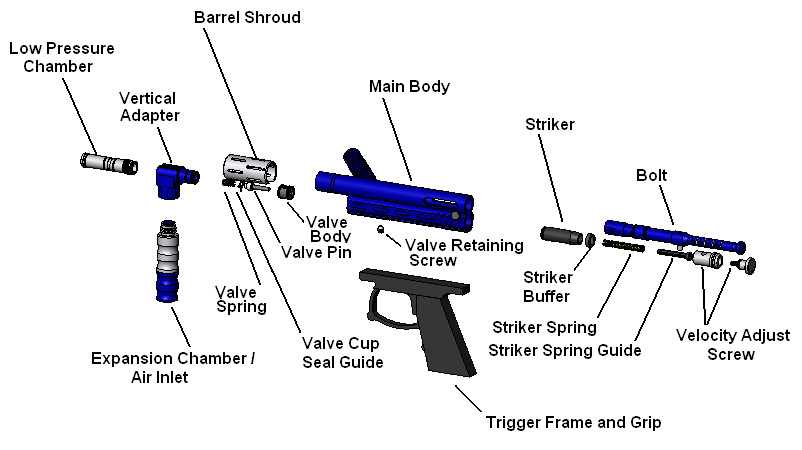Paintball marker
From DDL Wiki
Executive Summary
By way of our analysis of this paintball marker, the Spyder Shutter, we have identified several areas for design improvement. The following page will cover, in depth, our analysis of the product itself. In researching the conventional, and less conventional, uses of this particular marker, we have identified the primary objectives that this model would be expected to fulfill. The primary use of the Spyder Shutter is for entertainment purposes in conventional paintball games. By reviewing the customer needs and stake holders we have identified several areas for possible improvement on the Spyder Shutter. Customer needs are the main concern for the stake holders as the performance of the marker will ultimately determine the success and the possible profit gained. Some of the needs include easy assembly, reliability, and accuracy. The design of the marker must also be lightweight and easy-to-use as intended consumers can be as young as 10 years old, and incorporate several safety features for the same reason. The product requirements also cover what is needed to run the marker, particular inputs like air, oil, and paintballs, and the required output of a paintball at around 275 feet per second. Below, the operational procedure of the marker is covered in a step by step description and specific user considerations are identified. These considerations include assembly of the marker by disabled individuals, users with bad vision or weak arms, and facing clogged barrels. The report also includes a SolidWorks image of the marker and all of its components, as well as a detailed table which contains the names and description of the components and details on how these components are put together to form the marker.
With regards to the design for manufacture and assembly, we have concluded that the common components shared with other Spyder markers lead to lower production costs. The grip and trigger frame is used universally across many of the available models of this generation of Spyder marker. The Main Body was used across all of the Spyder markers, the milling and the power-feed are the only things that may change between models. The barrel threads are universal across Spyder markers and also fit some other brands allowing for customization options. Most of the exterior or main parts are built for flexibility and customization - a user could purchase the lowest end model and customize it into the high end model easily. In terms of design for the environment, the paintballs are completely biodegradable. The only parts of a paintball marker that would have environmental effect would be damaged o-rings that are thrown away and the oil used for lubrication, both of which are necessary but minimal. The marker is powered by CO2 which is released into the atmosphere. Although the amount of CO2 actually being released is minimal, there is an alternative of using compressed air instead, which is primarily composed of nitrogen and is more environmentally friendly. The possible modes of failure have also been investigated. The initial concerns to the user would be running out of air or paintballs. But long-term or more complicated failures would be damaged internal o-rings and air system, wear on moving parts, and a common issue in paintball, chopping paintballs with the motion of the bolt.
Through this analysis we have discovered possible items that can be improved or changed. These are both simple design changes for decreasing cost, but also larger improvements that may increase this marker's worth in the eyes of the consumer. Studying this product has also given us ideas for redesigning or even creating a whole new marker with different features that will still fulfill the primary needs of the consumer. Some new ideas may also be worthy of sparking new interest in the marker and creating opportunities for additional accessory lines, and thus, more sales and more profit. Basically, the design is well put together, but not perfect and far from innovative in the overall paintball industry.
Conventional and Unconventional Purposes
Below is a list of different uses customers have been know to use a paintball marker for. The most conventional use for it is paintball games for entertainment purposes.
- Marking Cattle
- Marking Trees
- Non-Lethal Live Action War Simulation Training
- Paintball Games
- Fun and Entertainment
- Law Enforcement
Some of these uses of a paintball marker seem far fetched and a little absurd, however they have been used for all of these purposes.
Customer Needs and Product Requirements
Paintball markers were initially designed for marking trees, trails and cattle. Today, the marker is predominantly used in the sport of paintball and as a result the product has needed to be altered so as to better fulfill the needs of this new scope of customers. A paintball player needs his/her marker to be sturdy and to be able to endure a significant amount of physical damage. The marker also needs to be easy to assemble/disassemble as well as easy for the user to clean, maintain and store away. Due to the fact that the user will be running around with the product, it needs to be lightweight and easy to hold/carry.
In terms of product requirements, the marker needs to be designed in such a manner that the paintball is fired out of the barrel at an adjustable velocity of between 250 and 300 ft/s (76 to 91m/s). This is due to the fact that at this velocity a paintball will not be traveling fast enough to severely hurt an opposing player (players would only suffer mild bruising when hit by a paintball) but it is still traveling fast enough so that it breaks upon impact. Most paintball fields limit users to a velocity of less than 280 ft/s. The marker needs to be made of lightweight materials so that the users can easily carry it and run with it. The marker also needs to be designed in such a manner that users can upgrade their markers conveniently. This includes upgrades such as changing the barrel, the trigger frame, the hopper (holds paintballs in marker), the gas tank and so forth. The marker's trigger frame needs to be constructed in such a manner that an average person's hand can hold the marker comfortably. Another factor which needs to be taken into consideration is that paintballs do not explode in the barrel itself. The marker must also be safe for the user to operate.
Summarized:
Customer Needs and Product Requirements
| Customer Needs | Product Requirements |
|---|---|
| Sturdy | Safety |
| Easy Assembly | Paintball Speed |
| Easy to Clean | Durability |
| Lightweight and Comfort | Lightweight and Comfort |
| Economical | Upgrade Options |
Inputs and Outputs
Below is a short list of all the inputs and outputs needed and produced to fire one paintball from the paintball marker. Each item is labeled for whether it is an input or an output.
- Pressurized CO2 (Input)
- Force of Pulling Trigger (Input)
- Paintballs (Input)
- Oil (Input)
- Paintball at High Velocity (Output)
- Expanded, Non-Pressurized CO2 (Output)
- Small amounts of excess oil (Output)
There are several inputs needed to fire one paintball from the marker. The most important of which is the pressurized CO2.
Stake Holders
There are several stake holders for paintball markers. These are the most common stake holders who the product affects the closest.
- Production Companies
- Paintball Gun Manufacturers
- Professional Paintball Players
- Recreational Paintball Players
- Retail Stores
- Paintball Arenas
The greatest stake holders are the paintball gun manufacturers. If their design is inferior in any way, people will not buy it and the company will lose money until they address the issue. Also, the paintball gun manufacturers are continually looking for possible improvements to gain an edge on the market.
Operation Procedures
Below is a complete list of steps required to fire off one paintball. The steps must be done in order for the marker to function properly.
1)Apply oil to CO2 tank connector
2)Cock bolt
3)Connect tank
4)Open CO2 valve
5)Dry fire 10-15 times
6)Attach barrel
7)Attach hopper elbow
8)Attach hopper
9)Fill hopper with paintballs
10)Engage power feed
11)Aim gun at target
12)Pull trigger
13)Repeat as neccessary
The setup is the most intensive part of firing the marker. Connecting the tank and applying the oil is very important before firing the marker.
Set-Up Notes
- Oil should be applied in order to protect internal parts and to prevent leaks
- Dry firing must be done before attaching barrel to cycle the oil through the system without coating the inside of the barrel which will cause inaccuracy
- Ensure security of parts such as the hopper, hopper elbow, barrel, and tank as well as the hopper cover after adding paintballs
- The CO2 tank used had an on/off valve that must be engaged manually, most tanks used have a pin valve which is engaged automatically when screwing tank onto adapter
Specific User Considerations
There are some user considerations that need to be addressed while designing a paintball marker. Some of these considerations are listed below and can be improved upon.
- Fatigue or weak arms can't lift gun steadily
- Extreme low temperatures
- Too rapid a rate of fire
- Assembly difficult for disabled users (lost arm, or finger)
- Bad vision
- Clogged Barrel or Debris in system
Debris in the system and the problems firing in low temperatures are possible considerations for design improvements.
Possible Areas of Improvement
Some areas where design improments can be made have been listed below. Many of these areas can be easily addressed, such as the trigger pull distance and gas efficiency.
- Shooting accuracy
- Shooting range and distance
- Gas efficiency
- Weight and size of marker
- Trigger pull distance
- Multiple projectile firing
- Reduction in number of components
- Ease of disassembly for cleaning and service
We have decided to address the area of multiple projectile firing.
Functional Operation
The following image is a section view of the paintball marker with the bolt in the cocked position and ready to fire. The description below describes the firing procedure and how each component is involved in propelling the paintball and re-cocking the gun for semi-automatic style firing. For a more detailed description and photo of each individual part, see the components list and exploded view below.
When the marker is at rest, the bolt and striker assembly are forward but not in a position that opens the valve becasue if the marker is pressurized before cocking the bolt, it will not leak throught he valve. The valve itself is closed by the valve in and cup seal which is plastic. This seal presses against the hole in the valve body sealing chamber 1 from chamber 2.
In order to fire the gun, you must first cock the bolt. This is done by pulling the bolt to the right until the striker (shown in red) engages with the trigger (shown in pink). When the trigger is pulled, the striker/bolt assembly is released and pushed to the left by the striker spring. While the bolt is moving, it pushes the awaiting paintball forward and prevents additional balls from entering the barrel by sealing off the paintball feeding tube. This also prevents air from flowing directly from the bolt into the ball feed rather than directed into the ball. The striker then hits the valve pin (shown in green) and opens a passage from chamber 1 to chamber 2. At this point, the passages to the barrel are both lined up and the pressurized air can flow into the barrel and propel the ball forward. Note this is a two part firing, as the bolt first contacts the ball to move it forward past the ball feed. Then the air pressure flowing through the bolt finises the job. The valve remains open only for a split second as the pressurized air flows through the valve body (shown in dark gray) into chamber 2 and propels the bolt/striker back to the right and re-cocks the gun for another firing.
Paintball Physics
The paintball is fired at a velocity of roughly 275 fps. How does the force caused by the air pressure create this kind of velocity and what sort of drag is seen on paintball as it leaves the barrel at this velocity? Furthermore, what kind of range does that leave for the paintball to travel and still carry enough velocity to break on the target?
The Paintball Diameter is .68 in.
The first measureable velocity is 275 fps at the end of the barrel.
In order to approximate the pressure required to launch the ball at this target velocity, we can calculate the average drag force and average acceleration of the ball in the barrel.
Drag = 1/2*Cd*A*v^2*rho
Half Area = 2*pi*r^2 = 0.726 in^2
Total Drag Force = approximately 0.5 lbs
To find the average acceleration of the paintball, we can use the equation Vf2 = Vi2 + 2*a*x where Vf is the final velocity (275 ft/s), Vi is the initial velocity (zero), a is the average acceleration, and x is the distance travelled (12 inches).
2752 = 2*a*1
a = 37813 ft/s2 = 11525 m/s2
To calculate the total force on the ball, we must use the equation F=ma, using a mass of .0032kg and an acceleration of 11525 m/s2. In this case, F = 36.9N = 8.3lbs. Since the total force must equal 8.3lbs and the drag force is 0.5lbs, the air pressure must provide a force of 8.8lbs. Using the equation Pressure = Force/Area, we can calculate the pressure:
Area = Pi * d2/4 = .3632 in2
Pressure = 8.8lbs / .3632in2 = 24.2psi
These calculations show that the air pressure in the barrel at the time of firing is only around 24psi.
Components
The following is a table detailing each component, its function in the marker, and the likely manufacturing process used to create it. Many of the components in the Spyder Shutter are made using conventional milling and turning, and could be easily created on standard machines without specific tooling. Because this marker shares many components with other markers in the Spyder line, it is clear that some high-volume manufacturing processes were used for common components. For example, the main body is made from a custom extrusion that is finish-machined to final shape to minimize wasted material and reduce costs associated with machining time. Also, a die casting is used for the trigger frame. Die castings are only cost effective when used in high volumes, and since the trigger is used for several different guns this is possible. Below the component list is an exploded assembly view of the marker and its internal components.
| Part # | Part Name | Sub-Assemblies | Qty. | Function | Material | Manufacturing Process | Image |
|---|---|---|---|---|---|---|---|
| 000 | Misc. Parts: Screws, nuts, pins, washers, o-rings | ALL | n/a | 1. Used for holding assemblies and parts in place 2. O-rings used for airseals 3. Lubricant used for wear protection and fluidity | Rubber/Silicon o-rings, steel screws, nuts, and other parts | Milled nut fittings for grip, purchased various other parts | |
| 01 | Barrel | n/a | 1 | 1. Direct ball after exiting marker 2. Cause pressure gradient decreasing paintball deformation 3. Unscrews for easy cleaning | Anodized Aluminum | Turned on Lathe, Drilled out porting, Milled for aesthetics | |
| 02 | Barrel Shroud | n/a | 1 | 1. Aesthetics 2. Shields barrel/body connection area | Plated Aluminum | Turned on Lathe and Milled | |
| 03 | Sight Rail with Beaver Tail | n/a | 1 | 1. Provides a reference for aiming in a straight line 2. Protects user from moving bolt 3. Aesthetics 4. Shields Bolt | Anodized Aluminum | Extruded and Milled to final shape | |
| 04 | Main Body | n/a | 1 | 1. Houses bot, striker, and valve sub-assemblies 2. Provides adapters for barrel, hopper, grip frame, ball detent, sight rail, and air system 3. Window to view movement of bolt 4. Color and milling for aesthetics | Anodized Aluminum | Aluminum Extrusion, Milling and Drilled Holes, Welded on Powerfeed, Reamed inner bores | |
| 05 | Trigger Frame & Grip | Trigger Frame & Grip | 1 | 1. Attaches directly to main body 2. Double trigger for increased fire rate 3. Trigger guard to prevent accidental trigger pull 4. Grip provides stability for holding marker 5. Internals control bolt release 6. Holds attachment for drop forward and grip covers | Aluminum Alloy frame and trigger, Steel pins and levers, wire springs | Diecast frame and trigger with finish drilling and machining, milled levers, ground pins, press fit pins for assembly | |
| 06 | .45 Grip Covers | Trigger Frame & Grip | 2 | 1. Attach to grip frame 2. Provide a rough grip 3. Hold drop froward nuts in place | Rubber | Injection Molded rubber | |
| 07 | Mini Drop Forward | Trigger Frame & Grip and Tank Adapter | 1 | 1. Attaches the tank adapter to the grip frame 2. Centers weight by moving tank forward 3. Milled for aesthetics and decreased weight 4. Lowers tank on marker | Anodized Aluminum | Milled and Polished, Drilled Holes | |
| 08 | Regulator/Expansion Chamber Assembly | Tank Adapter | 1 | 1. Transports air from tank to vertical adapter 2. Expansion chamber allows liquid CO2 to change to gas 3. Regulator controls flow from tank 4. Expansion chamber provides a front grip | Anodized Aluminum, Steel Fittings, Plastic Macroline hose, Pressure Gauge | Aluminum turned on lathe with additional Milling, machined nuts, air sealed hose and fittings | |
| 09 | Low Pressure Chamber | Tank Adapter | 1 | 1. Allows additional volume to hold gas 2. Seals front end of vertical adapter | Anodized Aluminum | Turned on Lathe | |
| 10 | Vertical Adapter | Tank Adapter | 1 | 1. Creates a 90 degree elbow from main body 2. Connects expansion chamber (or tank) to main body 3. Allows access to the valve assembly 4.Threaded for attachment of low pressure chamber | Anodized Aluminum | Block cut to size and "L"-shape, Milled and turned on Lathe | |
| 11 | Valve Body | Air Valve | 1 | 1. Provides seal surface for the cup seal 2. Transports air to the bolt when cup seal is opened | Aluminum | Turned on Lathe, milled and drilled | |
| 12 | Valve Cup Seal & Pin | Air Valve | 1 | 1. Seals valve when pressurized 2. Slides open when hit by striker allowing air flow | Stainless Steel Pin and Nylon Seal | Pin turned on Lathe and Milled Flat, Seal turned on Lathe | |
| 13 | Valve Cup Seal Guide | Air Valve | 1 | 1. Keeps valve pin and seal in line while moving 2. Open edges allow air flow around guide 3. Contact surface for valve spring | Plated Steel | Stamped | |
| 14 | Valve Spring | Air Valve | 1 | 1. Holds valve seal closed 2. Controls opening and closing of valve | Alloy Steel Wire | Wound wire | |
| 15 | Ball Detent & Cover | n/a | 1 | 1. Holds paintball in place before struck by bolt 2. Cover holds the rubber detent itself and screws onto main body | Anodized Aluminum Cover and Rubber Detent | Extruded and Milled cover with drilled holes and injection molded detent | |
| 16 | Bolt | Bolt & Striker | 1 | 1. Connects to the striker by steel pin 2. Allows gas flow from below through the bolt to the ball 3. Propels paintball 4. Coloring and grooving for aesthetics | Anodized Aluminum outer section with stainless steel inner piece and pin | Turned on Lathe and Drilled Outer piece, milled inner piece, turned pin, press fit pin | |
| 17 | Striker | Bolt & Striker | 1 | 1. Strikes the valve pin to open valve 2. Drives bolt forward and back 3. Surface for striker spring 4. Directs air from valve to bolt 5. Shaped to hook on trigger mechanism in trigger frame in "cocked" position | Steel | Turned on Lathe and Milled Flat, Black Oxide Finish | |
| 18 | Striker Spring | Bolt & Striker | 1 | 1. Drives striker into valve pin | Steel wire | Wound wire | |
| 19 | Striker Buffer | Bolt & Striker | 1 | 1. Prevents impact between striker and velocity adjuster | Rubber | Extruded and Cut | |
| 20 | Striker Spring Guide | Bolt & Striker | 1 | 1. Keeps spring in-line with striker 2. Provides contact surface for velocity adjustment | Hard Plastic | Injection Molded | |
| 21 | Velocity Adjuster | Bolt & Striker | 1 | 1. Thumbscrew allows easy velocity adjustment 2. Set screw provides velocity "lock" 3. Adjusts length of spring to adjust range of motion and air flow by way of the striker 4. Indented for quick disconnect pin | Anodized Aluminum | Turned on Lathe with Milled Slots and Holes | |
| 22 | Quick Disconnect Pin | Bolt & Striker | 1 | 1. Holds bolt and striker assembly in main body 2. Has hoel in end for locking pin | Stainless Steel | Turned on Lathe and Drilled Hole | |
| 23 | Powerfeed Plug | n/a | 1 | 1. Plugs bottom side of ball feed 2. Rotates 180 degrees to turn flow of paintballs on and off 3. Fully removes for cleaning | Plastic | Injection Molded |
Exploded View of Paintball Marker Components
Design Analysis
This is an analysis of some of the design features of the paintball marker. The first section highlights some of the design features and how they make assembly and manufacturing easier and more cost effective, as well as the manufacturing features that could be improved. The second section identifies several possible modes of failure of the marker and how those failures will effect the performance of the marker. The last section looks at the design features that may have some kind of effect on the environment.
Design for Manufacturing and Assembly - DFMA
Already Well-Designed Features
1. This is a design built from a "line" of markers, it shares many of the same main parts found in the rest of the line:
- This repeatability is very useful in cutting cost, it requires fewer production lines
- The Grip and trigger frame is used universally across many of the available models of this generation of Spyder marker
- The Main Body was used across all of the Spyder markers, the milling and the powerfeed are the only things that may change between models
- The barrel threads are universal across Spyder markers and also fit some other brands as well - allows for customization
- Most of the exterior or main parts are built for flexibility and customization - user could purchase the lowest end model and customize it into the high end model easily
2. The trigger frame is assembled in a permanent manner with press fit pins
- This reduces the number of screws and fasteners needed in assembly
- The pins also serve a dual purpose in securing the internal moving parts
3. In-Line assembly of bolt and striker
- The back half of internals (the bolt and striker assembly) are installed in-line and held in by a single quick disconnect pin
- This makes disassembly fast and tool-less
Room for Improvement
1. There is unnecessary milling and anodizing in the design of this marker
- Because this is the highest end model of this low end line, the milling and additional aesthetic improvements may or may not make up for themselves in selling points
2. Tolerances for fit of bolt and striker appear to be loose
- Addition of an inner sleeve for better fit would probably reduce wear between metal parts and increase efficiency
Because this marker is produced in high volumes and with a quality that is not above or below the expected, the cost of production is probably optimized as much as possible.
Failure Mode and Effects Analysis - FMEA
| Item or Function | Failure Mode | Effects of Failure | S | Causes of Failure | O | Design Controls | D | RPN | Recommended Actions | Responsibility | Comments | |
|---|---|---|---|---|---|---|---|---|---|---|---|---|
| Process of ball entering chamber and being struck by bolt | Chopped Paintball | - Ball shell jams bolt - Paint lines barrel and causes poor flight | 7 | - Brittle Paint - Rapid firing - Sharp edges | 4 | - Test in various conditions on: - rapid rate of fire - cold weather - hot/humid weather - loose barrel | 1 | 32 | - Check smoothness of barrel and body to barrel transition - Check barrel and paintball fit - Tighten fit between bolt and body - Make appropriate adjustments | Design engineers and manufacturing quality assurance | Breaking paintballs is inevitable and probably already minimized for this particular design | |
| O-ring on bottle | O-ring tears, stretches or is nicked | - Leaking of CO2 tank/adapter connection - Insufficient pressure to valve resulting in low velocity and possible inability to re-cock the bolt | 8 | - Old, worn-out O-ring - Improper application or lubrication of o-ring - Cross-threading of tank | 5 | - Testing life of o-rings under different conditions | 1 | 40 | - Supply users with additional o-rings and o-ring tool - Give instruction on when to replace o-rings | Packaging and Design | O-ring breakage is common but not typically covered in instructions given by manufacturers | |
| CO2 Tank Adapter and Drop Forward | Screws fall out, bend, and strip | Tank becomes unattached from marker | 7 | - Heavy tank attached to small mount - Extreme movement by player provides additional stresses to screws and mount - Only two small screws attach the drop forward to the grip handle - Loose screws | 2 | Perform failure analysis on screws by applying various loads and determine the necessary forces for failure | 1 | 14 | Strenthen attachment between drop forward and grip by adding additional screws or stronger screws | Design Engineers | This failure has occurred on our marker and would probably occur more because of user neglect rather than poor design | |
| Trigger Safety Mechanism | Damaged or missing safety button | Loss of safety feature prevents locking of the trigger when not in use | 5 | - Struck by paintball results in blowing safety out of grip - Other rough handling may result in loosening the safety button | 4 | - Obtain necessary force for pushing safety through grip | 1 | 20 | Devise new safety system that will hold under higher force threshold | Testing and Design | This failure has also occurred on this particular marker. The failure does not affect the performance of the marker but does compromise its safety. | |
| Bolt | Wear on material | - Creates more rattle during operation - May result in sharp edges increasing paintball broken during play | 6 | - Lack of lubrication between bolt and internal body - Too much rattle room between bolt and internal body - Uneven and inconsistent firing stroke of bolt - Metal on metal contact and rubbing | 7 | - Cycle test bolt to determine the length of life before failure results in unacceptable performance | 5 | 210 | - Provide necessary instruction to the user to lubricate the bolt - Tighten fit between bolt and internal body with a teflon sleeve or other smoother material | Design and Testing | Wear is visible on bolt but if user does not disassemble the marker to clean it, damage will not be seen and lubrication will be minimal. | |
| Paintballs and Air | Exhausting supply | Marker will not fire fully or at all if user runs out of air or paintballs | 8 | - Marker uses too much air pressure per shot - Inaccurate firing results in more firing and exhausting of supplies | 10 | - Testing of number of shots fired on given volume of CO2 in any number of conditions - Testing of possible rate of fire | 1 | 80 | - Optimize fluidity of system to decrease air pressure required - Increase accuracy through improving bolt and barrel to avoid additional firing by user | Design Engineers | Running out of air and paint is inevitable but can be optimized through these methods. |
In analyzing these modes of failure, we see some room for improvement, but minimal marketability for these improvements as these are issues that occur across the market for a variety of these mid- to low-end markers. We instead would like to pursue more innovative and creative designs while keeping some of these factors in mind. Primarily we are looking towards adding new products to the market rather than small adjustments to current products.
Design for Environment - DFE
1. For paintball in general, paintballs are completely biodegradable
2. The only parts of a paintball marker during the life of the marker that would have environmental effect would be damaged o-rings that are thrown away and the oil used for lubrication, both of which are necessary but minimal
3. The marker is powered by CO2 which is released into the atmosphere
- There is an alternative of compressed air, which is primarily nitrogen and is more environmentally friendly
- The amount of CO2 actually being released is minimal
- The use of CO2 is roughly twelve ounces per 2000 shots
- This usage certainly may be of concern when considering the energy required to harness this CO2
- Large CO2 tanks are readily available for filling small tanks but will consume negligible or minimal energy for filling paintball tanks compared to its other uses in various industries
4. The marker is made out of aluminum and steel primarily and is easy to disassemble, making post-life more environmentally friendly because of its re-usability
